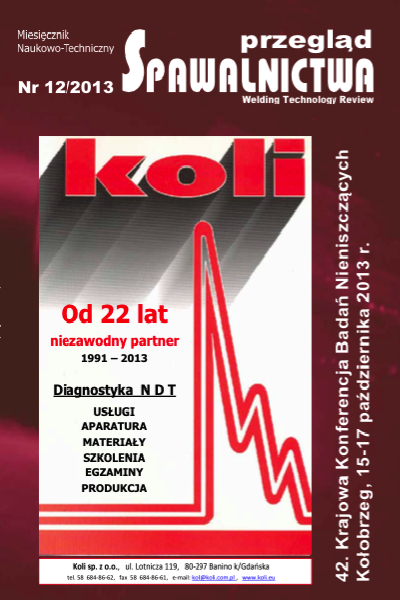Badania eksperymentalne wpływu geometrii na sygnał diagnostyczny w metodzie magnetycznej pamięci metalu
Main Article Content
Abstract
Dla próbek ze stali 16Mo3 badano wpływ geometrii na wartości składowych wektora natężenia własnego magnetycznego pola rozproszonego WMPR oraz na wartości ich gradientów. Stwierdzono dobrą relację składowej stycznej WMPR mierzonej w kierunku działania naprężeń głównych z wartościami zadawanych obciążeń. Widoczny jest wpływ geometrii próbek, lecz ilościowo jest on niewielki w stosunku do zmian wartości wywołanych obciążeniami. natomiast wpływ geometrii próbek na wartości gradientów jest znaczący. nie można tego wpływu pomijać przy opracowywaniu wartości granicznych kryteriów oceny w metodzie MPM, stąd też metodyka tej metody wymaga poprawy i uzupełnienia.
Experimental studies of the impact of geometry on the diagnostic signal in the metal magnetic memory testing method
abstract
The impact of geometry on the values of the residual magnetic field (RMF) strength vector components and on the values of their gradients was studied for 16Mo3 steel samples. A good correlation was found between the RMF tangential component measured in the direction of principal stress and the values of preset loads. The sample geometry impact is visible but in terms of quantity it is slight compared to the changes in values induced by varying loads. However, the impact of the sample geometry on the value of gradients is significant. This impact must not be ignored while developing boundary values of evaluation criteria in the MMM testing method, whose methodology should therefore be improved and supplemented.
Downloads
Article Details
Creative Commons CC BY 4.0 https://creativecommons.org/licenses/by/4.0/
Welding Technology Review (WTR) articles are published open access under a CC BY licence (Creative Commons Attribution 4.0 International licence). The CC BY licence is the most open licence available and considered the industry 'gold standard' for open access; it is also preferred by many funders. This licence allows readers to copy and redistribute the material in any medium or format, and to alter, transform, or build upon the material, including for commercial use, providing the original author is credited.
References
Deputat J.: Podstawy metody magnetycznej pamięci metalu. Dozór Techniczny 5/2002 s. 97-105.
Dietrych J.: System i konstrukcja, Wydawnictwa Naukowo-Techniczne, Warszawa 1978.
Roskosz M.: Kryteria oceny w metodzie magnetycznej pamięci metalu, Przegląd Spawalnictwa 13/2012 s. 31-34.
Roskosz M.,Bieniek M.: Analysis of the universality of the residual stress evaluation method based on residual magnetic field measurements, NDT&E International 54 (2013) 6368, http://dx.doi.org/10.1016/j.ndteint.2012.12.004.
Roskosz M.: Wpływ naprężeń czynnych i resztkowych na własne pole magnetyczne ferromagnetyków, Przegląd Spawalnictwa 13/2011 s. 46-49.
Roskosz M., Bieniek M.: Evaluation of residual stress in ferromagnetic steels based on residual magnetic field measurements nDT&E International 45 (2012) 5562, doi:10.1016/j. ndteint.2011.09.007.
Iwaniec M., Witoś M., Roskosz M., Gontarz S.: Diagnozowanie konstrukcji wsporczych linii Wn z wykorzystaniem efektów magneto-mechanicznych, 4 Konferencja Naukowo-Techniczna Diagnostyka Materiałów i Urządzeń Technicznych, Gdańsk 2012
Roskosz M., Bieniek M.: Analysis of the methodology of the assessment of the technical state of a component in the method of metal magnetic memory testing, Proceedings Defektoskopie 2010/ nDE for Safety, p.229-236.
Augustyniak M., Roskosz M. Hierarchia czynników wpływu w diagnostyce metodą statycznego pola rozproszonego, 41 Krajowa Konferencja Badań Nieniszczących, Toruń 2012.
PN-ISO 24497-1, 2, ,3 Badania Nieniszczące Magnetyczna pamięć metalu -- Część 1: Słownictwo, Część 2: Wymagania ogólne, Część 3: Kontrola złączy spawanych.
Własow W.T., Dubow A.A: Ocena poziomu naprężeń w strefach ich koncentracji według metody magnetycznej pamięci metalu. XIV Seminarium nieniszczące Badania Materiałów, Zakopane 2008.
